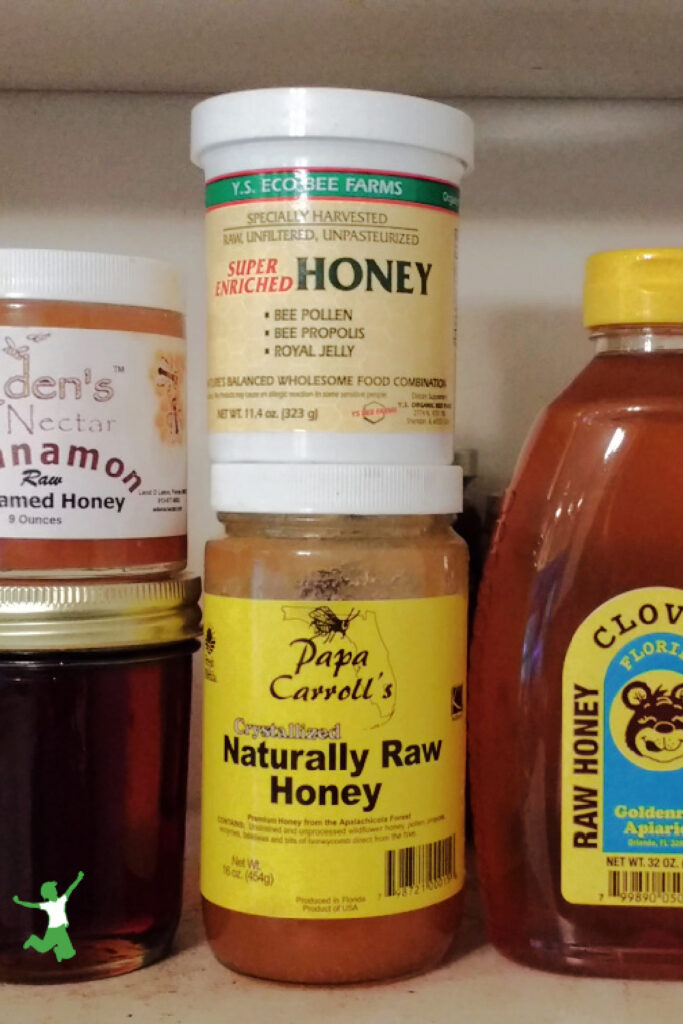The best types of raw honey, ranked cleanest to most contaminated, based on the pollution potential of the blooms supplying the nectar to the bees.

As a novice beekeeper, I’ve become very interested in knowing exactly where my bees are getting the nectar that they make into the raw honey I harvest for our family and friends.
Obviously, if the plants the bees are foraging nectar from are sprayed or otherwise growing in polluted areas, the raw honey will consequently be less than ideal or even contaminated!
This is one big reason why it is very important to know your beekeeper personally so that you know the exact location of his/her hives and whether that area is clean enough to consume honey from!
It’s also possible the bees could be foraging nectar from flowers of GMO plants such as canola, which has bright yellow flowers that bees are very attracted to.
Organic raw honey is a fantastic option if you can find a local source for it.
For raw honey to be certified organic, the USDA requires the apiary to be located in areas where nectar and pollen sources within a 3-mile (4.8 km) radius are predominantly organic or wild and free from prohibited substances (e.g., synthetic pesticides, herbicides, or GMOs).
This doesn’t mean every crop or plant must be certified organic within that radius, but the area must be sufficiently isolated from conventional agriculture to avoid contamination.
Since honeybees can forage as much as 5-7 miles from their hive, these organic standards aren’t perfect and only demand unsprayed flowers, crops and vegetation within the typical 1-3 mile honeybee foraging range.
Thus, the potential for bees to fly more than twice that distance is still a possibility.
Types of Raw Honey Ranked Best to Worst
Now that we’ve discussed how raw honey can be contaminated if there are pesticides/herbicides/GMOs within a 5-7 mile radius of the apiary, I will list the various types of raw honey that you may encounter at the farmer’s market or locally owned healthfood stores.
These “clean or contaminated” rankings would include creamed honey as well as liquid honey.
Hint: if a particular brand of raw honey does not list the nectar source on the label and you cannot ask the beekeeper directly about the whereabouts of the apiary to confirm pollution-free zones, I would suggest avoiding it to be on the safe side.
Cleanest
Below are the types of raw honey that have the least potential for chemical residues.
Manuka
Raw manuka honey (Leptospermum scoparium) is at the top of the list for the cleanest type of honey you can buy. Found in Australia and New Zealand, these native bushes primarily grow in remote areas with very low possibility for contamination.
That said, manuka honey is very strong-tasting and best for medicinal use rather than topping a bowl of oatmeal or mixed into yogurt.
This type of honey is also not local for the majority of the planet, so utilizing manuka as a natural antibiotic is how I use it in our home.
Tupelo
Tupelo honey comes from the nectar of the tupelo gum tree (Nyssa ogeche).
These native trees grow in the pristine, unsprayed swamps of Florida and Georgia.
The isolated wetlands that are home to tupelo gum trees have short bloom yields, which works to further favor their high status as the cleanest raw honey in the United States.
For this reason, tupelo honey is often able to be certified organic.
Given that Florida has also banned chemtrails (as of July 2025), the likelihood of bloom contamination from the skies is low as well.
Thus, next to the honey produced by my own beehives, tupelo is my preferred honey to buy locally as I live in Central Florida.
Acacia
Blooms from the acacia tree (Robinia pseudoacacia) provide the plentiful nectar for honeybees to make acacia honey.
These trees primarily grow in untouched forests that would be exposed to little to no chemical spraying.
Sourwood
Sourwood honey comes from blooms of the sourwood tree usually in remote areas of the Appalachian Mountains with little to no pollution or contaminants.
Sometimes Clean, Sometimes Not
The types of raw honey below can sometimes be clean enough to eat, but often are not.
If you have a source for these types of honey that you enjoy, be sure to check the exact location of the apiary to ensure no polluted areas are within a 5-mile radius.
Linden
The blooms of the linden trees provide the nectar for this type of honey.
These trees are usually found in urban or urban adjacent areas rather than pristine forests or mountains. Thus, linden honey has a higher potential for contamination.
If you live in a rural area, this type of local honey is likely fine.
Orange Blossom
Orange groves provide the amazingly sweet nectar for this type of honey.
Orange blossom honey is my personal favorite type of honey. However, I will only buy it if certified organic because the conventional orange groves where these apiaries are typically placed are fairly heavily sprayed.
Clover
Like orange blossom, conventional clover honey has the potential for residues given that it normally comes from mixed pastures with farms nearby that likely employ some type of spraying.
If you love the taste of clover honey like I do, look for it from local beekeepers who can attest to its purity.
Dirtiest Types of Raw Honey
The following types of raw honey have a high likelihood of contamination and/or glyphosate residues.
It is best to avoid them unless you obtain it from a beekeeper who can personally attest to its purity.
- Alfalfa honey. Field crop that is likely highly sprayed and/or Roundup Ready alfalfa.
- Sunflower honey. Intensive monoculture with high neonicotinoid detection.
- Buckwheat honey. Dark honey with pesticide residues likely.
- Rapeseed (canola) honey. Very high likelihood that the honey is from GMO blooms.
What About Wildflower?
The honey from my backyard apiary comes from wildflowers in the area. These plants are unsprayed in large open fields within about 1 mile of my home.
Thus, I am quite confident that it is clean.
If you enjoy wildflower honey, it can be clean or contaminated based on the location.
Wildflower honey’s cleanliness hinges on the foraging radius (up to 5-7 miles from the apiary).
Remote wildflower honey ranks high due to pristine sources, while agricultural or urban variants are best avoided due to the likelihood of contaminant exposure.
Below is a short video of a recent harvest of the clean wildflower honey from my backyard apiary. No expensive equipment is needed! It is such a fun hobby, which I highly recommend!
References
(1) USDA Organic Certification
(2) Organochlorine pesticide residues in Uganda’s honey as a bioindicator of environmental contamination and reproductive health implications to consumers
(3) Determination of neonicotinoids and 199 other pesticide residues in honey by liquid and gas chromatography coupled with tandem mass spectrometry









Thanks for this article, so helpful!
Great article — you’ve clearly explained how the nectar source for honey impacts its purity, and the list of raw honey types from clean to contaminated is really useful. I especially appreciate the note about how bees can forage 5-7 miles from hives, which many people don’t realise. It really underlines why knowing the beekeeper and the local environment matters when choosing honey. Thanks for putting this together!
Dr Paul Saladino just did a video stating that Manuka came back high in pesticides. So, I don’t know. Will have to research this more. Thank you for this information.
Was it 100% manuka honey? Most manuka on the market (80%) is fake. https://www.thehealthyhomeeconomist.com/manuka-honey/
Sarah what is your opinion on bees given sugar feed during the winter? I’ve always been told to avoid this but requires calling up the producer and asking for a truthful answer.
The issue with many of these companies is that they dont operate farms and only package from several suppliers. Beekeeper naturals is an example.
I don’t feed sugar water to my bees even during the winter, and I don’t think it’s a good idea, generally speaking. The honey then comes at least partially from sugar water and not nectar. Beekeepers do this for the most part to increase yield and profits. I think it is important to know if the bees which made your raw honey were fed sugar water (which would be from GMO white sugar from beets in many cases!!)
The only time I would consider feeding sugar water is if the hives are in danger of collapsing due to lack of food. I did this after hurricane Milton last year which wiped all the blooms off the trees and other plants for several weeks. I fed my bees minimal (cane) sugar water (nonGMO) so the hives would survive.
You can meet beekeepers in person at farmer’s markets and there are at least two in my area that do not feed sugar water and are good sources for 100% nectar-based honey.
Honestly, the over-reliance on sugar water to feed bees is a big reason why raw local honey often does not work for people who seek it to help with allergies. There is little to no pollen in that raw honey!
Hi! What do you think of azure standards raw honey?
It is fine if it is one of the “clean” types mentioned in this article (not necessary to be certified organic) or certified organic for types that might not be as clean depending on the surrounding area (such as clover).
Sarah – Thank you very much! This post is so helpful.
We’ve kept bees, but do not currently have a hive. I hope to capture a wild swarm next year to fill our hive again!
Our farm yard is surrounded by conventional farm fields. A few years ago, when we had bees, my son regularly observed them foraging on our yard. That year there was a canola crop on the field around our yard. My son said our honeybees were ALL over the sweet clover on our yard, but he couldn’t find any on the canola, which was in full bloom. I think the bees will avoid GMO and chem and choose other things that are better and closer to home if they can.
I’ve been listening to a lot of podcasts and stuff about honeybees lately to prep for keeping bees and one lady I listened to said that the biggest chem contamination in honey comes from the treatments that conventional beekeepers use directly in the hive.
I’ve observed the bees where we live for many years now and I’m pretty sure most of the chem spraying on commercial farm fields is done before the biggest foraging season starts. We’re gradually reducing our chem use on fields and our spraying is done long before our crops bloom. We’re also planting lots of bee-friendly trees and shrubs on our yard to keep the bees close to home (our yard is chem-free!).
– Katie
This is a great story, thank you for sharing. Yes, animals will instinctively avoid GMO crops if there are other better options! I’ve heard from multiple farmers over the years that presenting GMO feed and nonGMO feed to animals, that they will choose the nonGMO every time. Squirrels are the same … they will eat a nonGMO corncob in the yard and avoid the GMO corn cob. They will only eat GMO if there isn’t another choice.